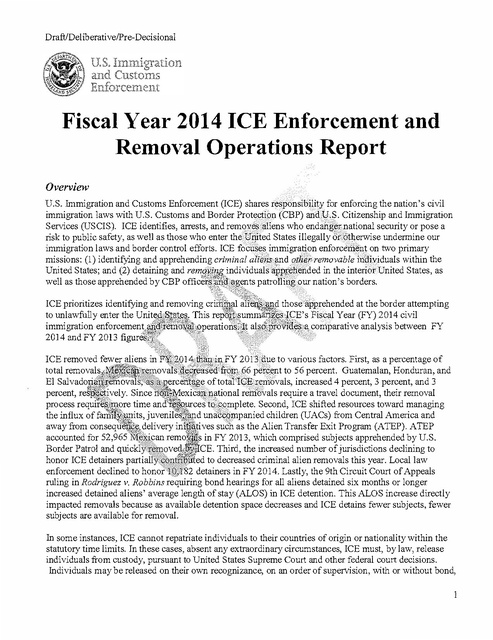ICE Enforcement and Removal Operations Report - Fiscal Year 2014 (Draft), ICE
Download original document:

Document text

Document text
This text is machine-read, and may contain errors. Check the original document to verify accuracy.
Draft/Deliberative/Pre-Decisional
Fiscal Year 2014 ICE Enforcement and
Removal Operations Report
Overview
U.S. Immigration and Customs Enforcement (ICE) shares responsibility for enforcing the nation's civil
immigration laws with U.S. Customs and Border Protection (CBP) andp.s. Citizenship and Immigration
Services (USCIS). ICE identifies, arrests, and removes aliens who endarigfr national security or pose a
risk to public safety, as well as those who enter the UIJited States illegally or.otlierwise undermine our
immigration laws and border control efforts. ICE focusesimmigration enforcemerit on two primary
missions: (1) identifying and apprehending criminal aliens andother removable individuals within the
United States; and (2) detaining and remgying-jndividuals apprehended in the interior United States, as
well as those apprehended by CBP officet�;.an.1 Agxnts patrolling our nation's borders.
ICE prioritizes identifying and removing c;iiliiil:{���ri§,i!l\a, those ipprehended at the border attempting
to unlawfully enter the Unit�g0�,tilte� This rep;�,�umn1�i��JSE's Fiscal Year (FY) 2014 civil
;
immigration enforcement,f!:!igµ,efu6�f!.
... }•..8Perations}I. ! alsQ)Jrovidx�'il
... .comparative analysis between FY
2014 and FY 2013 fi gure'sifc'
ICE removed few e,r�liens i::�*{•29IttJ� i11 FY 20r3 ctue to various factors. First, as a percentage of
total removal�,;;�,i�i.��l)'.
ovalst4fS\"�aseclfi-orn, 66 perc;�nt to 56 percent. Guatemalan, Honduran, and
El Salvadoti1,1l1l�efuoval ,
··.. ,�rcen:tage of total ICE �e.movals, increased 4 percent, 3 percent, and 3
percent, reij;��tively. Since ii0:�11).1exicari,n,�tional removals require a travel document, their removal
process require§l:!\)ore time ancltii'.ffrces to5omplete. Second, ICE shifted resources toward managing
the influx offarrii�@,JW;its,juveniles\]lfiWd unacc8mpanied children (UACs) from Central America and
. delivery in1]!�tives such as the Alien Transfer Exit Program (ATEP). ATEP
away from consequeijt�
;,,;<·'+!::
':''\<''.
accounted for 52,965 · : · ·can remoii1
. s in FY 2013, which comprised subjects apprehended by U.S.
veg£��1;\ICE. Third, the increased number of jurisdictions declining to
Border Patrol and quick!
honor ICE detainers partial
"'' 'tited to decreased criminal alien removals this year. Local law
'82 detainers in FY 2014. Lastly, the 9th Circuit Court of Appeals
enforcement declined to honor
ruling in Rodriguez v. Robbins requiring bond hearings for all aliens detained six months or longer
increased detained aliens' average length of stay (ALOS) in ICE detention. This ALOS increase directly
impacted removals because as available detention space decreases and ICE detains fewer subjects, fewer
subjects are available for removal.
In some instances, ICE cannot repatriate individuals to their countries of origin or nationality within the
statutory time limits. In these cases, absent any extraordinary circumstances, ICE must, by law, release
individuals from custody, pursuant to United States Supreme Court and other federal court decisions.
Individuals may be released on their own recognizance, on an order of supervision, with or without bond,
1
Draft/Deliberative/Pre-Decisional
Criminality
ICE Levels reflect priorities outlined in the June 2010 memorandum entitled "ICE Civil Immigration
Enforcement Priorities effective October I, 2010." Since FY 2011, ICE has defined criminality as a
recorded criminal conviction from certified criminal history repositories. To prioritize the removal of
convicted criminal aliens, ICE personnel refer to the following offense levels: Level I, Level 2, and
Level 3 offenders. Level I offenders are aliens convicted of"aggravated felonies," as defined in§
I Ol(a)(43) of the Immigration and Nationality Act, or two or more crimes, each punishable by more than
one year, commonly referred to as "felonies." Level 2 offenders are aliens convicted of any other felony
or three or more crimes, each punishable by less than one year, corru:iJ.only referred to as "misdemeanors."
Level 3 offenders are aliens convicted of "misdemeanor" crime(S))iunishable by less than one year. Prior
to FY 2011, ICE used Secure Communities (SC) Levels I, 2, and3 for prioritization purposes.
Intakes and Releases
Detention data exclude Office of Refugee Resettlement facilities and United States Marshals Service
prisoners.
Final Book-outs include only the followingR,elease Reasons: [ATD, Bonded Out, Order of Recognizance,
Order of Supervision, Paroled, ProsecutoriaLI)ifpretion].
The data represent the number of final book-out� as den;g<c:� above" A;final book-out is the last book-out
in a detainee's length of
during FY 2014 YTD, he/she is
alien ha§,J:J.1ultipl1::��;ci.\Jiook-buts
· ·
··
··
counted once for each
11





